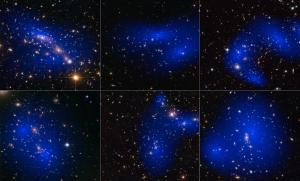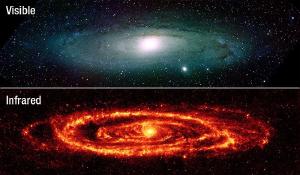Blog
Darker Matter
27 March 2015
 NASA, ESA, D. Harvey, and R. Massey
NASA, ESA, D. Harvey, and R. MasseyThere’s nothing like dark matter to fire up a discussion about astrophysics. We have lots of evidence to support dark matter, and we’ve determined some of it’s physical properties such as the fact that it is cold rather than hot (ruling out things like neutrinos). But because we don’t know everything about dark matter, and since we haven’t directly detected dark matter particles in a lab, there are constant accusations from the general public that dark matter is just a “patch” over our ignorance, or that astronomers have simply made up dark matter in order to keep the status quo (and our jobs) alive. If we can’t see it, the argument goes, then we can’t be certain it exists. Except we can see it, such as the blue smudges in the image above.
 Spitzer/Kitt Peak National Observatory
Spitzer/Kitt Peak National ObservatoryThe image shows a false-color representation of dark matter in six different galaxy clusters. Just as we can’t see infrared directly, but can detect it’s presence through CCD cameras, we can detect dark matter by its gravitational effects on background light. The images are part of a recent work that analyzed the dark matter distribution in 72 colliding galaxy clusters.1 The results have further defined the nature of dark matter. For one thing, the distribution of regular matter and dark matter are distinctly different in these clusters. So much so that the team can validate the existence of dark matter to 7.6σ. In other words, the chance of these results being a false positive is
But the results didn’t stop there. Because these are colliding galaxy clusters, the dark matter from each region is colliding as well. Since dark matter is diffuse rather than clumped into stars, when dark matter collides it will interact, and the strength of this interaction can be determined by the resulting distribution. We measure the interaction strength of particles as a cross section, and this work shows that the self-interaction cross section for dark matter is less than 0.47 cm2/g. This is quite small, and it means that not only is dark matter weakly interacting with regular matter, it’s weakly interacting with itself. Basically, it’s even darker than we thought.
This constraint is strong enough that it eliminates some of the models trying to extend the standard model of particle physics. It also puts into question some of the claims of gamma rays being produced by colliding dark matter. There are still things to learn about dark matter, and we’d still love to detect dark matter directly, but the claim that dark matter might not exist is untenable at this point.
Harvey, David, et al. “The nongravitational interactions of dark matter in colliding galaxy clusters.” Science 347.6229 (2015): 1462-1465. ↩︎